必修3_Unit_2_Healthy_eating[单元教案]
- 格式:doc
- 大小:67.50 KB
- 文档页数:19
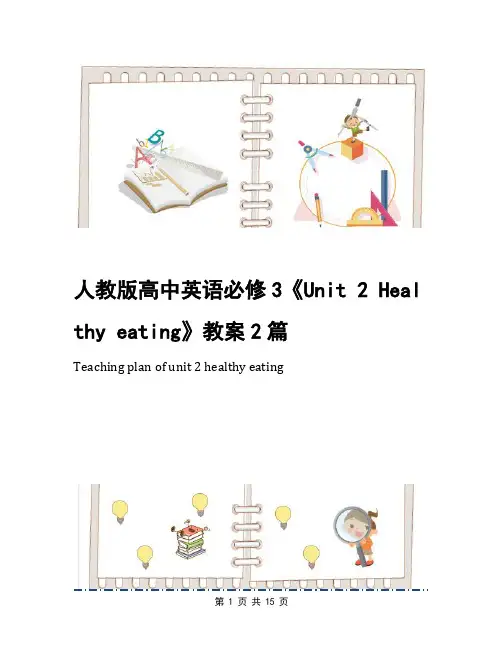
人教版高中英语必修3《Unit 2 Heal thy eating》教案2篇Teaching plan of unit 2 healthy eating人教版高中英语必修3《Unit 2 Healthy eating》教案2篇前言:英语作为在许多国际组织或者会议上都是必需语言,几乎所有学校选择英语作为其主要或唯一的外语必修课。
英语教学涉及多种专业理论知识,包括语言学、第二语言习得、词汇学、句法学、文体学、语料库理论、认知心理学等内容。
本教案根据英语课程标准的要求和教学对象的特点,将教学诸要素有序安排,确定合适的教学方案的设想和计划、并以启迪发展学生智力为根本目的。
便于学习和使用,本文档下载后内容可按需编辑修改及打印。
本文简要目录如下:【下载该文档后使用Word打开,按住键盘Ctrl键且鼠标单击目录内容即可跳转到对应篇章】1、篇章1:人教版高中英语必修3《Unit 2 Healthy eating》教案2、篇章2:人教版高中英语必修3《Unit 2 Healthy eating》教案篇章1:人教版高中英语必修3《Unit 2 Healthy eating》教案教学准备教学目标1.Get students to learn the useful new words and expressions in this part: cucumber, eggplant, pepper, mushroom, peach, lemon, nut, pea, spaghetti, diet, curiosity, customer, discount, ought to, lose weight, get away with, tell a lie, win…back.2.Let students have a better understanding of the reading passage.教学重难点mportant points1.Let students have a good understanding of the passage.2.Get students to learn different reading skills.◆ Difficult pointsGive students some guidance about how to choose the correct answers of the multiple choices according to some key words and key sentences.教学过程一学生课外学习活动设计:任务一:学生调查问卷:(1)What does a balanced diet should contain?(2) Why are you so strong/weak/fat/thin? Does it have anything todo with your diet?任务二:Making a diet for yourdinner.根据泛读学到的健康饮食的知识,为自己的家庭涉及晚餐食谱,分析食谱里包含哪些种类的食物,判断其能否提供均衡的营养,并分析原因。
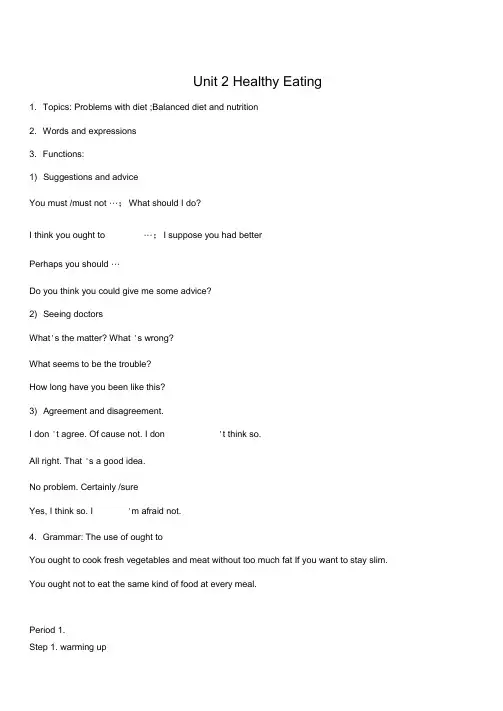
Unit 2 Healthy Eating1. Topics: Problems with diet ;Balanced diet and nutrition2. Words and expressions3. Functions:1) Suggestions and adviceYou must /must not …;What should I do?I think you ought to …;I suppose you had betterPerhaps you should …Do you think you could give me some advice?2) Seeing doctorsWhat's the matter? What 's wrong?What seems to be the trouble?How long have you been like this?3) Agreement and disagreement.I don 't agree. Of cause not. I don 't think so.All right. That 's a good idea.No problem. Certainly /sureYes, I think so. I 'm afraid not.4. Grammar: The use of ought toYou ought to cook fresh vegetables and meat without too much fat If you want to stay slim. You ought not to eat the same kind of food at every meal.Period 1.Step 1. warming up1. Do you eat a healthy diet? What kind of food do you usually have for meals? Are the food you usually eat healthy food or unhealthy food?(Discuss in pairs)2. Name some healthy food and unhealthy food.healthy food unhealthy food.All vegetables: cabbages, Fatty food: French friesPeppers tomatoes potatoes cream roast pork/lambAll fruits: apples, grapes sugary food: chocolateStrawberries bananas pears sweets/honey ice-creamDairy products: Milk cheese salty food: can biscuitSeafood: shrimp cookiesTofu eggs3. Do you know that the food you eat helps you grow in different ways? Some will make you fat/tall/thin. Look at the charm below, and see which kind of food they.FOOD TO GIVE YOU ENERGY FOOD TO GROW BONESAND MUSCLE Foods that fiber fordigestion and healthFast energy food Slow energy food Body-building food Protective foodsRice sugarNoodles potatoesSpaghetti breadCorn dumplings Butter creamOils ham nutsFried bread stickFried cake/chips Dairy products:Milk cheeseMeat eggs tofuSeafood shrimp All vegetables(eg. beans. Cucumbers, mushrooms, peas, Cabbage, …)all fruit(pears Apples, peaches, oranges, …)Questions:1. Which of these groups of food do you like best?2. Which of them do you eat most often?3. Do you think we should eat each kind of food?3.What will happen if you do not eat a balanced diet?Too much fatty/sugary/salty food will cause many diseases and get too fat.Only protective food will feel weak ,no energy and get too thin.Step 2. Pre-reading1. Discuss the questions in the chart.(Which food contains more … )2. Order the following food from which contains most fat to which contains less.Answer: ice-cream, eggs, chicken, rice, peachesStep 3 Fast reading and answer the following questions1. What does Wang Peng wei 's restaurant serve?2. What about Yong Hui ' s restaurant?Step 4 Intensive reading and find the answers to comprehending.Period 2 Language pointsStep 1.Lead-in: Listen to the tape to get a better understanding.Step nguage points1. Wang Pengwei sat in his empty restaurant feeling very frustrated.feeling very frustrated 现在分词在句中作伴随状语eg.She sat on the chair reading a newspaper.(表伴随)Walking in the street, she met her old friend. (表时间)Seeing no body at home, she decided to eat outside.(表原因)The child fell, striking his head against the ground. (表结果)2. His restaurant ought to be full of people.Ought to 1) to show a moral duty 表示一种道义上的责任,应该Eg. She ought to look after her child better.You ought to study hard to get a high mark.2)ought to have done 表示本应该…,而却没有…Eg. You ought to have come yesterday.3. He thought of his mutton kebabs, fatty pork cooked in the hottest oil. 语,表过去分词短语作后置定被动。
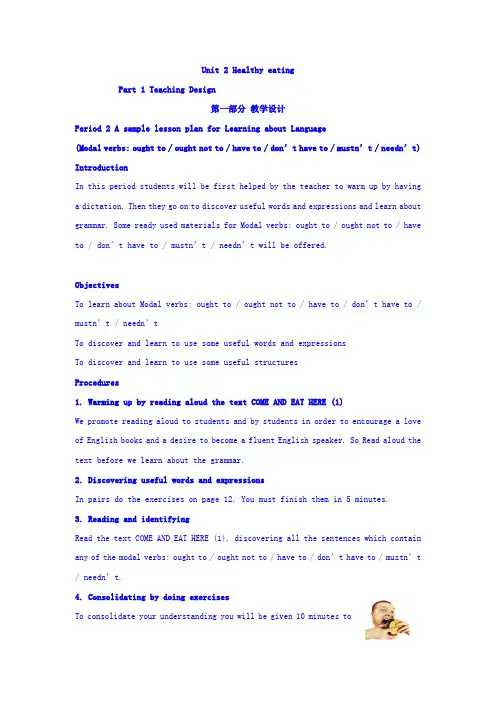
Unit 2 Healthy eatingPart 1 Teaching Design第一部分教学设计Period 2 A sample lesson plan for Learning about Language(Modal verbs: ought to / ought not to / have to / don’t have to / mustn’t / needn’t) IntroductionIn this period students will be first helped by the teacher to warm up by having a dictation. Then they go on to discover useful words and expressions and learn about grammar. Some ready used materials for Modal verbs: ought to / ought not to / have to / don’t have to / mustn’t / needn’t will be offe red.ObjectivesTo learn about Modal verbs: ought to / ought not to / have to / don’t have to / mustn’t / needn’tTo discover and learn to use some useful words and expressionsTo discover and learn to use some useful structuresProcedures1. Warming up by reading aloud the text COME AND EAT HERE (1)We promote reading aloud to students and by students in order to encourage a love of English books and a desire to become a fluent English speaker. So Read aloud the text before we learn about the grammar.2. Discovering useful words and expressionsIn pairs do the exercises on page 12. You must finish them in 5 minutes.3. Reading and identifyingRead the text COME AND EAT HERE (1), discovering all the sentences which contain any of the modal verbs: ought to / ought not to / have to / don’t have to / mustn’t / needn’t.4. Consolidating by doing exercisesTo consolidate your understanding you will be given 10 minutes togo over exercises on page 13. You may just write in your text book. I mean the student’s b ook you are working by.5. Reading the ready used materials for Modal verbs: ought to / ought not to / have to / don’t have to / mustn’t / needn’t(用原版)For reference: (用原排版)6. Closing down by doing a quiz品味人生1、不管鸟的翅膀多么完美,如果不凭借空气,鸟就永远飞不到高空。
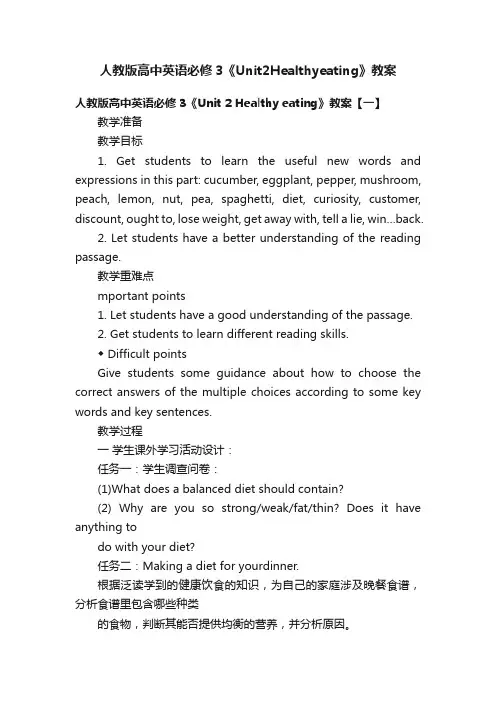
人教版高中英语必修3《Unit2Healthyeating》教案人教版高中英语必修3《Unit 2 Healthy eating》教案【一】教学准备教学目标1. Get students to learn the useful new words and expressions in this part: cucumber, eggplant, pepper, mushroom, peach, lemon, nut, pea, spaghetti, diet, curiosity, customer, discount, ought to, lose weight, get away with, tell a lie, win…back.2. Let students have a better understanding of the reading passage.教学重难点mportant points1. Let students have a good understanding of the passage.2. Get students to learn different reading skills.◆ Difficult pointsGive students some guidance about how to choose the correct answers of the multiple choices according to some key words and key sentences.教学过程一学生课外学习活动设计:任务一:学生调查问卷:(1)What does a balanced diet should contain?(2) Why are you so strong/weak/fat/thin? Does it have anything todo with your diet?任务二:Making a diet for yourdinner.根据泛读学到的健康饮食的知识,为自己的家庭涉及晚餐食谱,分析食谱里包含哪些种类的食物,判断其能否提供均衡的营养,并分析原因。
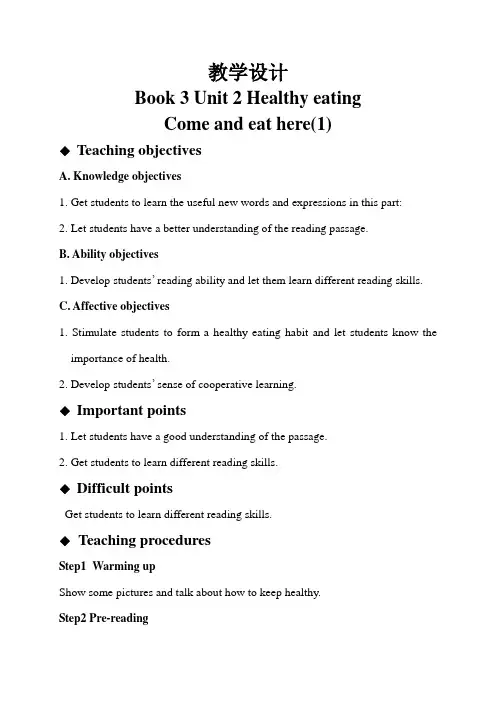
教学设计Book 3 Unit 2 Healthy eatingCome and eat here(1)◆Teaching objectivesA. Knowledge objectives1. Get students to learn the useful new words and expressions in this part:2. Let students have a better understanding of the reading passage.B. Ability objectives1. Develop students’ reading ability and let them learn different reading skills.C. Affective objectives1. Stimulate students to form a healthy eating habit and let students know the importance of health.2. Develop students’ sense of cooperative learning.◆Important points1. Let students have a good understanding of the passage.2. Get students to learn different reading skills.◆Difficult pointsGet students to learn different reading skills.◆Teaching proceduresStep1Warming upShow some pictures and talk about how to keep healthy.Step2 Pre-readingTalk about healthy eating.Step3 Reading①Skimming:Go through the passage and find out some information.1.Who were mentioned in the text?2.Where did the story happen?3.What’s the main ide a of the passage?A.Yong Hui opened a small restaurant near Wang Peng’s restaurant.B.Wang Peng visited Yong Hui’s restaurant with curiosity.C.Wang Peng found out the reason why he lost his customers and wanted towin them back.D.Wang Peng was unhappy because pe ople came to Yong Hui’s restaurant.②Scanning:True or False ?1.The food in Yong Hui’s restaurant cost more than that in Wang Peng’srestaurant. ( )2.Yong Hui’s menu gave customers more energy-giving food. ( )③Careful reading: Choose the correct answer.1.When Wang Peng thought “Nothing could be better”, he meant .A.his food and drinks were the bestB.his food and drinks were the worstC.his food should have been improvedD.he could do nothing with his food and drinks2. Why did Wang Peng go into the newly-opened restaurant?A.Because he was angry.B.Because he was curious.C.Because he wanted to blame its owner.D.Because he wanted to ask for advice.3. According to the passage, we can infer that .A.Wang Peng felt frustrated because his res taurant wasn’t full of people.B.Wang Peng was amazed at the menu and prices in Yong Hui’s restaurant.C.Yong Hui’s menu gave customers more energy-giving food.D. Wang Peng found out Yong Hui’s restaurant served more fat than his.④Summary: Sum up the story with some suitable words.Wang Peng felt frustrated his customers didn’t come to his restaurant as they (usual) did.Out of (curious), he (follow) Li Chang, was his friend, to a newly-opened restaurant. He was amazedthe menu and the prices. Then he went to the library (do) some research. He found that Yong Hui’s customers didn’t eat enough energy-giving food to keep (health). Wang Peng felt hopeful when he drove back home. Perhaps with a discount and a new sign he could win his customers .The (compete) between the two restaurants was on.Step4 DiscussionIf you were a manager of a restaurant, ,what would you do ? Step5 Homework1.Preview the text: Come and eat here(Ⅱ)2.Design a poster for Wang Peng’s restaurant.Step6 Blackboard designUnit 2 Healthy Eating--reading。
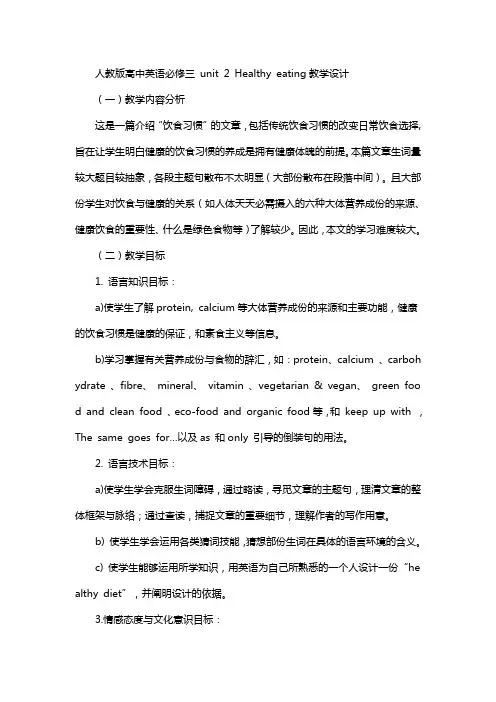
人教版高中英语必修三unit 2 Healthy eating教学设计(一)教学内容分析这是一篇介绍“饮食习惯”的文章,包括传统饮食习惯的改变日常饮食选择,旨在让学生明白健康的饮食习惯的养成是拥有健康体魄的前提。
本篇文章生词量较大题目较抽象,各段主题句散布不太明显(大部份散布在段落中间)。
且大部份学生对饮食与健康的关系(如人体天天必需摄入的六种大体营养成份的来源、健康饮食的重要性、什么是绿色食物等)了解较少。
因此,本文的学习难度较大。
(二)教学目标1. 语言知识目标:a)使学生了解protein, calcium等大体营养成份的来源和主要功能,健康的饮食习惯是健康的保证,和素食主义等信息。
b)学习掌握有关营养成份与食物的辞汇,如:protein、calcium 、carboh ydrate 、fibre、mineral、vitamin 、vegetarian & vegan、green foo d and clean food 、eco-food and organic food等,和keep up with ,The same goes for…以及as 和only 引导的倒装句的用法。
2. 语言技术目标:a)使学生学会克服生词障碍,通过略读,寻觅文章的主题句,理清文章的整体框架与脉络;通过查读,捕捉文章的重要细节,理解作者的写作用意。
b) 使学生学会运用各类猜词技能,猜想部份生词在具体的语言环境的含义。
c) 使学生能够运用所学知识,用英语为自己所熟悉的一个人设计一份“he althy diet”,并阐明设计的依据。
3.情感态度与文化意识目标:a)使学生学会审视自己、审视食物,提高养成健康饮食习惯的意识。
b)使学生知道:健康是做好一切事情的根本。
要想有强健的体魄,除合理安排好一天的生活之外,还需要有科学、卫生的饮食习惯,天天必然量的体育活动和体力劳动。
青少年必需有健康的身体,长大以后才能成为一名具有现代科学文化,适合时期要求的合格劳动者。
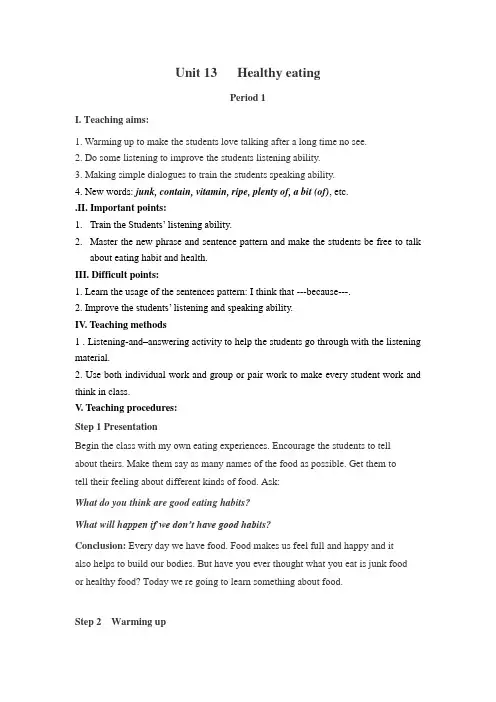
Unit 13 Healthy eatingPeriod 1I. Teaching aims:1. Warming up to make the students love talking after a long time no see.2. Do some listening to improve the students listening ability.3. Making simple dialogues to train the students speaking ability.4. New words: junk, contain, vitamin, ripe, plenty of, a bit (of), etc..II. Important points:1.Train the Students’ listening ability.2.Master the new phrase and sentence pattern and make the students be free to talkabout eating habit and health.III. Difficult points:1. Learn the usage of the sentences pattern: I think that ---because---.2. Improve the students’ listening and speaking ability.IV. Teaching methods1 . Listening-and–answering activity to help the students go through with the listening material.2. Use both individual work and group or pair work to make every student work and think in class.V. Teaching procedures:Step 1 PresentationBegin the class with my own eating experiences. Encourage the students to tell about theirs. Make them say as many names of the food as possible. Get them totell their feeling about different kinds of food. Ask:What do you think are good eating habits?What will h appen if we don’t have good hab its?Conclusion: Every day we have food. Food makes us feel full and happy and italso helps to build our bodies. But have you ever thought what you eat is junk foodor healthy food? Today we re going to learn something about food.Step 2 Warming up1. Have the students open their books at Page 1 and look at the eight pictures of different kinds of food. Tell the names of the food first. Then discuss in pairs: which of them are junk foods? Why?Or which of them are healthy foods? Why?2. Ask your classmates what they like to eat. The students may have a discussion in pairs and then make a list of the food and decide whether what they like to eat is junk food or not.3. According to the discussion, fill in the table with real information.Step 3 Listening1. Tell the students they are going to have some listening training. Let them know that something is wrong with Mike. Make them listen to the tape once and tell what is the problem with Mike and what he did next.2. Look at Ex. 1 on P2 and listen to what happened to Mike. The students are to answer the questions in it after a short discussion.3. Listen to what Mike did next, and then answer the question in Ex. 2. A short discussion is allowed in pairs.Step 4 SpeakingEveryone wants to be healthy and strong. But sometimes we are not feeling well. Ask:What will you d o if you don’t feel well?Say: When we’re ill, we’d better go and see a doctor and the doctor will look over us and give us some advice. Now we’re going to practice some everyday English used by doctors and patients. Go through the useful expressions on P3.Have the students look at the example above. Ask two students act as Dr Yang and Sharon and read the dialogue aloud. Have the other students underline some useful expressions they can find.Go through the three situations with the students on P2. Ask them to choose one of them and make up a dialogue in pairs according to the example given and then actit out.Step 5 ConclusionToday we’ ve done some listening and speaking, and learn how to give advice and some everyday English used between doctors and patients.HomeworkPreview the reading passage in this unit.Period 2I. Teaching aims:1. 1. Learn and master the following words and expressions: make choices, pace, diet, nutrient, muscle, bean, keep up with, fibre, mineral, chemical balance, fit, be good for, function, and be harmful to, etc.2. Improve the students’ reading ability and study the language points connected with the text..II. Important points:1. Train the Students’ reading ability.2. Master the new phrases and wordsIII. Difficult points:How to make the students understand the reading text better.IV. Teaching method1 . Fast reading for the students get the general idea first.2. Discuss after reading to understand the text better.3. Careful reading to get the detailed information.V. Teaching procedures::Step 1 PresentationAsk the students what in their mind are healthy foods and what are junk foods. Help them to get a conclusion that we must develop healthy eating habits.Step 2 Pre-readingShow the students the pre-reading questions. Get them to discussion in groups. Ask individual students to give a report about their own answers to them. Ask: What do you think of your own eating habit? Is it healthy or not?Step 3 Fast ReadingSay: today we come to the Reading. It’ s abou t a healthy diet and tells the importance of keeping healthy eating habits. Read the text quickly and find the answers to the questions on the screen..1. What do traditional diets often have?A. too much waterB. too much proteinC. too much fat and too many caloriesD. nutrients we need2. What can help our body fight disease and give us energy?A. vitamins, fibre and minerals.B. pork and fishC. waterD. calcium3. What contains a lot of protein?A. vegetablesB. fruitsC. vitaminsD. fish, meat and beans4. Why do some people become vegetarians?A. Because they believe it is healthier not to eat meat or they think we shouldnot kill animals for food..B. Because they think meat is not "eco-foods".C. Because they think meat will make them Fat.D. Because riley think meat will make them thin.5. From the passage we can conclude that it is probably better, ifA. we eat less meatB. we have more fruitC. we have "eco-foods"D. we buy good food and keep a balanceddiet.参考答案:CADADStep 3 Careful reading1.Give enough time to let the students read the text carefully again, and tell themain idea of each paragraph.2.The students read the text paragraph by paragraph. The teacher ask as manyquestions as possible for the students to answer. Give the students someexplanations to some difficult sentences or phrases. Pay attention to the new words and expressions.3.Play the tape for the students to listen and follow.4.Give the students some time to ask questions about the points they don’tunderstand.Step 4 Post-reading1. Do post-Reading 1- 32. Discuss the questions below, first in pair, then with the rest of the class.(1)Why do people go to fast food restaurant?(2)Why is it not good for you to eat too much sugar and fat?(3)Why are crash diets and supplements so popular?(4)What can we do to keep a balanced diet?Step 5 ConclusionHave two top students to make a conclusion about what we have learned in this class and what we can learn from this text. The teacher should speak highly of their answers. If possible, add some necessary information.HomeworkGo through the whole text and retell it.Get prepared for next class.Period 3I. Teaching aims:1. Review the text learnt in the last period including useful words and expression.2. Learn how to use had better, should and ought to while giving advice.3. New words and phrases: ought to, column, gram, sticky, etc..II. Important points:1. Master the usages of had better, should and ought to.2. Remember the words from the text.III. Difficult points:How to use had better, should and ought to correctly in different situations.IV. Teaching methods:1.Group or pair work to get the students do better in class.e competition to make the students active in class.V. Teaching procedures:Step 1 PresentationIn this class we’re going to review the words we learnt and also learn how to give advice using had better, should, and ought to. Write them on the blackboard.Step 2 Word studyMake the students open their books at page 5 and look at this part.First make the students work out the words in pairs. Give them some time to remember the answers.A competition:Get the students to close their books. The teacher reads out the descriptions and the students are to speak out the words as quickly as possible. See which group get the most correct answers.Step 3 GrammarThe teacher can tell the students when people use had better or had better not,should or should not, ought to or ought not to. Write down one or two examples for each phrase and try to make sure that the students understand all the usages by asking them to give their own examples.Then have the students fill in the blanks in Ex. 1 on P5 in a right way.Step 4 PracticeRead through the title with the students and let them get clear about what they are going to do with this exercise. They will try to write letters giving advice. Read the letters asking for advice quickly, then write down four pieces of advice for each of them using had better (not) , ought (not) to or should (not) .Step 5 WorkbookBooks open at P72. Do Exx. 1-3.HomeworkGo over the grammar by finishing the exercises on P73 in grammar part.Period 4I. Teaching aims:1. Do some reading about Snacks.2. Do some writing to develop the students writing skill..II. Important points:1. Train the Students’ writing ability by getting to know how to write a recipe..2. Improve their reading ability by reading this passage.III. Difficult point:Improve the students’ integrating skills.IV. Teaching methods1 .Asking-and –answering activity to go through the reading material.2. Individual and pair work.V. Teaching procedures:Step 1 RevisionCheck the answers to the exercises on P73 wit h the studentsMake sure all the students understand the grammar we learned in last class. If possible, go over it with the students.Step 2 Reading1. Skim the reading text and answer:What can we do if we need more energy besides eating our main meals?2. Read the text again quickly, do the following True-or-False exercises.1) Our body doesn’t need to refuel if we choose nutritious food for our mainmeals.2) Good snacks should come from different food groups and should not havetoo much fat or sugar.3) Fruits and vegetables don’t give us any vitamins.4) Most fruits need cooking.5) Fruits and vegetables are the only healthy snacks.参考答案:1. F2.T3.F4.F 5F3. Give the students some explanations when necessary.4. Play the tape and have the students follow. Give them some time to askquestions.Step 5 WritingGo through the two recipes on P7 carefully.Read the tips to the students to let them know for sure how to write a recipe.Have the students work in pairs and write the recipe for their favourite dish.Step 6 CheckpointUse Checkpoint 13 to help the students go over the grammar and usefulexpressions they have learned in this unit.HomeworkFinish off the workbook exercises.。
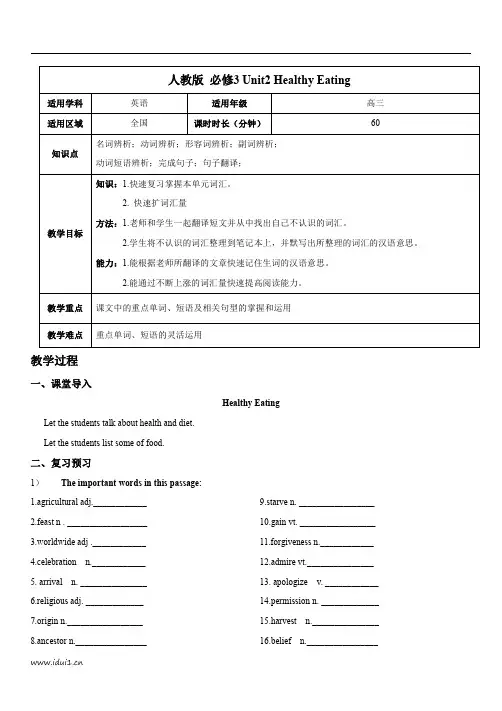
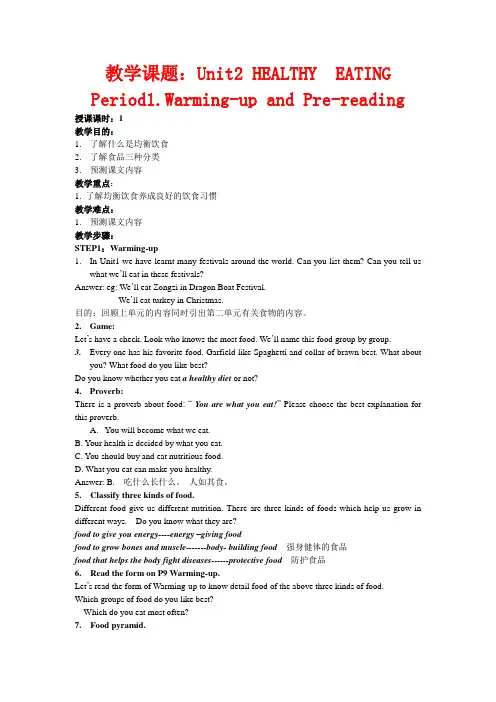
教学课题:Unit2 HEALTHY EATING Period1.Warming-up and Pre-reading授课课时:1教学目的:1.了解什么是均衡饮食2.了解食品三种分类3.预测课文内容教学重点:1. 了解均衡饮食养成良好的饮食习惯教学难点:1.预测课文内容教学步骤:STEP1:Warming-up1.In Unit1 we have learnt many festivals around the world. Can you list them? Can you tell uswhat we’ll eat in these festivals?Answer: eg: We’ll eat Zongzi in Dragon Boat Festival.We’ll eat turkey in Christmas.目的:回顾上单元的内容同时引出第二单元有关食物的内容。
2.Game:Let’s have a check. Look who knows the most food. We’ll name this food group by group.3.Every one has his favorite food. Garfield like Spaghetti and collar of brawn best. What aboutyou? What food do you like best?Do you know whether you eat a healthy diet or not?4.Proverb:There is a proverb about food: “You are what you eat!” Please choose the best explanation for this proverb.A.You will become what we eat.B. Your health is decided by what you eat.C. You should buy and eat nutritious food.D. What you eat can make you healthy.Answer: B. 吃什么长什么。
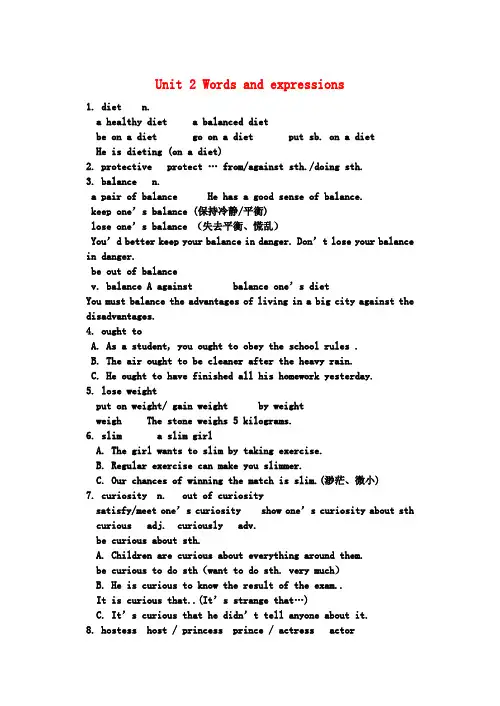
Unit 2 Words and expressions1. diet n.a healthy diet a balanced dietbe on a diet go on a diet put sb. on a dietHe is dieting (on a diet)2. protective protect … from/against sth./doing sth.3. balance n.a pair of balance He has a good sense of balance.keep one’s balance (保持冷静/平衡)lose one’s balance (失去平衡、慌乱)You’d better keep your balance in danger. Don’t lose your balancein danger.be out of balancev. balance A against balance one’s dietYou must balance the advantages of living in a big city against the disadvantages.4. ought toA. As a student, you ought to obey the school rules .B. The air ought to be cleaner after the heavy rain.C. He ought to have finished all his homework yesterday.5. lose weightput on weight/ gain weight by weightweigh The stone weighs 5 kilograms.6. slim a slim girlA. The girl wants to slim by taking exercise.B. Regular exercise can make you slimmer.C. Our chances of winning the match is slim.(渺茫、微小)7. curiosity n. out of curiositysatisfy/meet one’s curiosity show one’s curiosity about sthcurious adj. curiously adv.be curious about sth.A. Children are curious about everything around them.be curious to do sth(want to do sth. very much)B. He is curious to know the result of the exam.. It is curious that..(It’s strange that…)C. It’s curious that he didn’t tell anyone about it.8. hostess host / princess prince / actress actor9. get away withA. How can he get away with telling lies again and again?B. You will never get away with speaking to your parents like that.C. The thieves robbed a bank and got away with a large sum of money.(偷完某物后潜逃)get away from 离开、脱身get across to sb. 使人理解(了解、清楚)get down to sth./doing sth.开始认真做某事get in 进入、收获 get over 恢复、克服get sb down 使人沮丧get along with get through get out of10. lie n./v.tell a lie / tell lies / lie to sb. lie inlie lied /lied lie lay / lain lay laid / laidA.The problem lies in the engine.B.Shanghai lies in the east of China.C.The boy lied that the cock lying there laid a gold egg.11. discount at a discount get/give/offer a discountA. The store offered/gave a 10% discount on goods before Christmas.B. Do we get a discount if we buy them in quantity?12. win … back win back one’s trust win back voterswin a game/match/war/prizebeat/defeat sb./ a team defeat the enemy13. strength strong weakness weakA. He is a man of great strength and he has the strength to lift a huge stone.B. Everyone has his own strengths and weaknesses.14. consultconsult a dictionary/a reference book (查找、查阅)turn to a dictionary / a reference booklook up a word in a dictionaryconsult sb.(a teacher)A. He has consulted the lawyer about the matter.(咨询、请教)B. The doctor will consult with the child’s parents about the operation.与…商量、向…征求许可15. earn one’s living earn a livingmake a/ one’s living (by doing sth. /as a…)16. debtbe in debt to sb. 欠某人的债、欠某人的人情债be in sb’s debt 欠某人的人情债、受某人恩惠而感激某人You have been so kind to us that we will always be deeply in your debt/in debt to you.be out of debt 免于债务go/get/run into debt 陷入债务 pay off one’s debts 还清债务17. glare at stare at glimpse atglance at (一瞥、粗略的看一眼) look atA. Peter was angry and glared at the rude waiter. / and gave the waiter an angry glare.B. It’s impolite to stare at foreigners on the streets.C. She glanced shyly at him and then lowered her eyes.18. spy n./v.He is a spy and is spying on us secretly. We must take care.19. limit v./n. limit… to…限制…到…A. There is a time limit to what you will do.B. We must limit expense to what we can afford.我们必须把开销限制在我们的经济能力范围内without limit 无限地 within limits 适度地、有限度地be limited to局限于…C. He is willing to devote his limited life to serving the people without limit.20. benefit n./v. be of great benefit to 对…有好处for the benefit of 为…的利益have the benefit of 受到...好处A. Exercise is of great benefit to us. So we should take exercise regularly for the benefit of our health and we will have the benefit of good health in the future.(获益于好的身体)B.Exercise will benefit our health and we will benefit from goodhealth.benefit v. 有益于、有利于 benefit from/by 从…中获益C. Who is likely to benefit by the new tax law?21. combine combine …with… be combined with…A. We consider it necessary to combine theory with practice.B. Several factors combined to ruin our plans.C. Can you combine water with oil?22. cut down缩减、减少某事物,改小裁短衣服,砍到、杀死,夺去…的生命,损害…健康A. You should cut down smoking for the benefit of your health.B. We are doing all we can to cut down studying time and improve quality.C. The workers are cutting down trees.cut off cut in cut up cut out (删除,切除)23. before long long beforeA. He will come back before long.B. It won’t be long before he returns.C. Dinosaurs had died out long before human beings came into being. Warming up and Pre-reading1. eat a balanced diet eat a healthy diet2. in different ways3. provide energyprovide sb. with sth. provide sth. for sb.supply sb. with sth. supply sth. to sb.offer sb. sth. offer sth. to sb.provide for (赡养、提供生计)He has a wife and five children to provide for/ support.provided/providing that…(假若、倘若)Provided it snows tomorrow, we won’t go outing.4. three kinds of food : energy-giving food, body-building food, protective food5. go into a good meal6. invite sb. for dinnerReading:1.Wang Peng sat in his empty restaurant feeling very frustrated.A.The students walked out of the classroom, talking andlaughing.B.They all worked deep into the night, preparing for theconcert.C.Hearing the news, he jumped with joy.(时间状语)D.Being ill, he didn’t go to school.(原因状语)ually he got up early prepared his menu of…….prepare sb. for sth. and prepare for sth. prepare sth.be prepared to do sth. be prepared for sth.make preparations for in preparation for3.What could have happened?Something terrible must have happened if Li Chang was not coming to eat in his restaurant as he always didmust have done sth.can’t/couldn’t have done sth. could have doneA. She couldn’t have passed the exam without hard work.( if she hadn’t worked hard.)B. Most students could have finished their homework several daysago.A. You must have read the book, have you?B. She must have come here yesterday, didn’t she?A. You should do as I say!B. Why didn’t you catch the last bus as I told you?4. Nothing could be better.(比较级表最高级)A. ___ Let’s go for a picnic, shall we?___ I couldn’t agree more. It sounds great.B. Nobody loves money than Tom.C. I have never heard a better voice than his.5. see sb. hurrying by see sb. do sth.feel , listen to / hear, see / look at / notice / watch / observe , find…..6. be tired of be tired from/with be tired outHe was tired from climbing the high mountain but he isn’t tired of climbing mountains.7. Curiosity drove Wang Peng inside.drive + object + adv./adj./prep./to do (驱赶、驱使)(逼迫、迫使)A.Tourists were driven indoors by the heavy rain.B.The farmer is driving the cattle along the road.C.Very loud noise will drive people mad.D.Poverty and hungry drove him to steal.8. be amazed at be surprised atamaze amazing amazedamazement to one’s amazement9. He couldn’t have Yong Hui getting away with telling people lies. have sb. doing sth.(在肯定句中“让…一直/持续做某事”在否定句中, “不允许,不容忍某人做某事”)A. She had us laughing all the time.B. I won’t have you speaking to your teacher like that.C. Her parents won’t have her staying up so late.get away withIf you cheat in the exam, you will never get away with it. 10. …Wang Peng was surprised to find that his restaurant served far too much fat…..too much much tooA.What you said just now is too much for a little girl.B.He spends too much time playing computer games.C.The problem is much too difficult for the students to work out.far too much far adj.11. Even though her customers might get thin after eating Young Hui’s food, they were not eating enough energy-giving food to keep them fit.Even though he knew the advice to be valuable, he still turned a deaf ear to it.get thin get worried about get used to sth. get coldget hurt/injured/wounded get marriedget changed (换衣服、得以改变) get dressed (梳妆打扮)get lost get caught get trapped (被困)keep sb. fit/healthy keep healthy/fit keep silent keep warm 12. The competition between the two restaurants was on.(在进行、再继续)What’s on at the cinema ?What’s on in today’s China Daily?on fire on holiday on leave on sale on strikeReading and discussing:1.Perhaps he would be able to earn his living after all and not haveto close his restaurant.earn a/one’s living as/by make a /one’s living2.He didn’t look forward to being in debt because his restaurantwas no longer popular.be in debt to sb be in sb.s debt pay off one’s debts 3.She didn’t look happy but glare at him.not …but He is not my friend but my enemy.glare atI angrily glared at the rude man.= I angrily gave the rude man a glare.The sun glares.(阳光闪耀)4.I didn’t want to upset you, but I found you menu so limited that I stopped worrying and started advertising the benefits of my food. find sb./sth. + adj. (make, prove, leave, think consider, keep...)A.I consider your advice valuable/useful.B.You shouldn’t keep yourself so busy.C.They proved him guilt/innocent.benefit benefit sb. benefit from/bybe of great benefit for the benefit of。
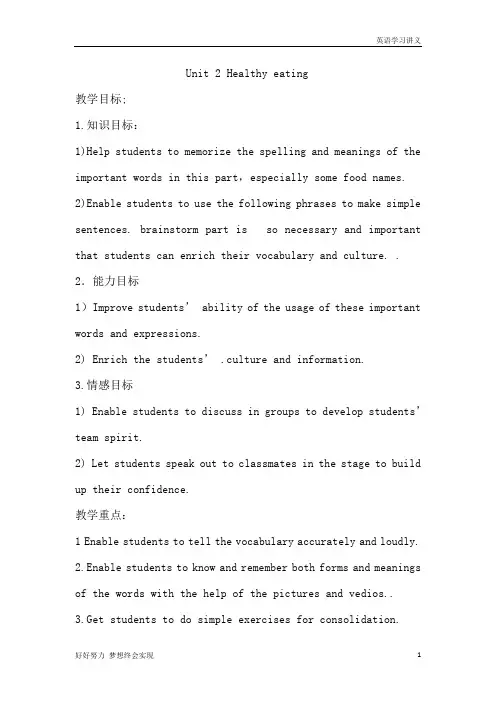
Unit 2 Healthy eating教学目标;1.知识目标:1)Help students to memorize the spelling and meanings of the important words in this part,especially some food names. 2)Enable students to use the following phrases to make simple sentences. brainstorm part is so necessary and important that students can enrich their vocabulary and culture. . 2.能力目标1)Improve students’ ability of the usage of these important words and expressions.2) Enrich the students’ .culture and information.3.情感目标1) Enable students to discuss in groups to develop students’team spirit.2) Let students speak out to classmates in the stage to build up their confidence.教学重点:1 Enable students to tell the vocabulary accurately and loudly.2.Enable students to know and remember both forms and meanings of the words with the help of the pictures and vedios..3.Get students to do simple exercises for consolidation.教学难点:1. Let students master the usage of the following key words and expressions in this unit.2. Get students to disdinguish the different genders of one word and remember relevant phrases.3. make studentds understand the meaning of the message. 教学过程:Step1 Lead-inHello, everyone!Today we are going to learn Unit 2.Healthy eatingLet students watch a short vedio for several minutes and encourage them to know by heart.make the students understand The meaning of the passage.Step 2 自主学习检测(识记词汇)A. wordsB.phrasesc.passageStep 3合作探究(分组讨论,)Some words and expressions are of great importance in this unit. Let us pay more attention to them , try your best to recite them and write the usage of these vocabulary on the blackboard and then speak out to classmatesStep 4 拓展延伸(教师)Make the students not only un6 总结反刍In this period, we have got familiar with the psssage and expressions in this unit. What is the most important is to master the usage of the phrases. Thus practicing after class is necessary. Try to do more exercises to consolidate them. Step7 Homework1. Learn the words and expressions by heart.2.read the passage.。
教学准备1. 教学目标教学目标知识与技能 1.Students will be able to get familiar with the following words and expressions: You must …./You’d better …./I would strongly advise you to …/My adv ice is …./I think you ought to …./You might …./It might be a good idea to …./Perhaps you should ….过程与方法 1. Stude nts will be able to learn to predict the content of the story2. Students will be able to understand the text and say something about keeping a balanced diet情感态度价值观 Students should be taught to keep a balanced diet and keep healthy.Students will be able to learn to cooperate with their team members in group discussion.2. 教学重点/难点教学重点 Students will be able to how to keep a ba lanced diet through reading.教学难点 Students will be able to use some expressions to give som e a dvice about how to keep healthy?3. 教学用具4. 标签教学过程Teaching proceduresStep1 Pre-readingLearn these proverbs.You are what you eat. 人如其食。
Unit 2 Healthy eating I.单元教学目标II.目标语言Ⅲ. 教材分析与教材重组1. 教材分析本单元以“健康饮食”为中心话题,通过单元教学让学生了解各种食物对人体的作用,引导学生关注平衡膳食,促使学生养成健康饮食的习惯。
针对现实中遇到的实际问题发表自己的看法。
最后让学生运用所学知识,两人一组研究中餐,设计食谱。
1.1 WARMING UP是本单元一个重要的组成部分。
让学生看图讨论不同食物对人体的作用,了解饮食与人体健康的关系。
通过几个设问激发学生思考自己的饮食习惯是否合理,运用已有的知识经验思考什么是Healthy Eating.1.2 PRE-READING 通过一个表格和一个排序题引导学生对比不同食物中哪些食物富含脂肪、纤维素、维生素和糖份。
可添加讨论如何在烹饪中保持食物营养,从而有利于健康。
1.3 READING 讲述王鹏和咏慧开饭店的不同风格和顾客对不同食品的反应,反映了现代人对饮食的关注和对时尚的追求。
但王鹏和咏慧都没有提供平衡的膳食,经过一段时间的磨合,他们决定合作,提供既有能量又有纤维的食品。
戏剧性的结尾增添了故事的趣味性。
通过阅读丰富学生的饮食文化,教会他们如何改善饮食习惯;在现实生活中碰到麻烦时,如何正确处理矛盾,解决问题。
1.4 COMPREHENING 利用判断和回答问题的形式考查学生对课文细节的理解,对比两家饭店所提供膳食的优缺点。
1.5 LEARNING ABOUT LANGUAGE 是继Comprehending之后的又一指导性练习。
注重考查词性的变化,课文中重点词汇在语篇中的熟练运用及情态动词的不同功能,并设计连线和情景对话两个题型予以巩固。
1.6 USING LANGUAGE 体现了学以致用的目的,从Listening, Reading, Speaking, Writing 四方面训练学生,完成语言的输入性学习和输出性训练的过程,结合生活实际,让学生两人一组研究中餐设计食谱。
Unit 2 Healthy Eating 教案Teaching Aims:1.Knowledge aimsStudents shall be able to learn the basic usage of the following modal verbs: can/could; may/might; must/have to; shall/should; will/wouldImportant points1.The usage of each pair of the modal verbs2.The sameness and difference among these pairs of modal verbs3.Correctly understand the change modal verbs bring to the sentences, that is, their functions. Step 1 Revision1.lead inT: First wealth is health. What should/shouldn’t we do to keep healthy? What kind of food must we eat to be strong? What ought we to eat to stay slim?__________________________________________________________2.Give some more situations to revise the usage of the modal verbs.a. My mother cooked a lot of food for me. She has been cooking all the morning.- She must be tired now.b. I have just eaten a lot of food.- You can’t be hungry now.c. My house is near the railway. It must be noisy there.d. She called me yesterday evening but I didn’t hear. I must have been asleep.e. The old restaurant must be very good. It’s always full of people.f. The new restaurant can’t be very good. It’s always empty.g. Where is Bob? Perhaps he is in the office. He may be in his office.h. Where is Jane? Perhaps she is reading the newspaper. She may be reading the newspaper.i. Perhaps she was ill yesterday. She might be ill yesterday.j. Perhaps she went fishing yesterday. She might go fishing yesterday.k. In China many children have to wear uniform when they go to school.l. Don’t tell anybody wha t I said. You must keep it a secret.m. The floor is clean. You needn’t sweep it.n. I promised I would be on time. I mustn’t be late.o. Last night Paul became ill suddenly. We had to call the doctor.p. It’s sunny today. You needn’t take the umbrella.q. We can’t repair the car ourselves. We have to take it to a garage.r. I can manage the shopping alone. You needn’t e with me.s. That is an important book.. you must look after it carefully.t. You look tired. You should go to bed now.u. You shouldn’t believe everything you read on the Internet.v. Excuse me, could you tell me the way to the railway station, please?w. You are carrying a lot of things. You can’t open the door yourself. There is a man standing near the door. You say to him: Could you open the door, please?x. Would you like a cup of coffee?3. Get the students to list the modal verbs that they have learned.can/could may/ might will/ would had better shall/ should must have toneed ought to dare4.. Explain the modal verbs in the following sentences.1).He can speak English well.2).You can go home now.3)That can’t be true.4).Could you please show me the way to BeihaiPark?5).They hunters are lost. They could starve.6).May I e in?7).He may give you some help?8).Don’t worry. I will help you.9).Often he would dress up like a rich man.10).Would you like to join us for dinner?11).You shall have the ticket as soon as I get it.12).You should arrive at the airport two hours before he goes.13).It is five o’clock. He should turn u p soon.14).Wang Feng wins an award every year. He must be strongStep 2 Discovering useful structuresPlease pick out all the sentences containing modal verbs from the reading passage and list them. Match the function words in the box with each of the sentences. Then make three new sentences.A. IntentionB. DutyC. PromiseD. PossibilityE. Guessing1.By lunchtime they would all be sold.2.His restaurant ought to be full of people.3.What could have happened?4.Nothing could have been better?5.Something terrible must have happened.6.I will take all that fat off you in two weeks.7.He could not believe his eyes.8.He wondered if he should go to the library to find out.9.He couldn’t have Yong Hui getting away with telling people lies.10.He had better do some research.11.After eating in the restaurant people would bee fired very quickly.Step 3 ExercisesFinish Ex.2-3 on P13Step 4 Using structuresAsk your classmate questions using the phrases in the table (on P50). Then plete the following table according to the example.Example:YOU: Miki, do you often go to fast food restaurants?MIKI: No, I don’t.You write “No” in the table and then give your own opinion or suggestions, like “I think he is right. We shouldn’t eat too much fast food, otherwise it will cause health problems.” using must(n’t), should(n’t), ought (not) to and (don’t) have to in your suggestions and opinions。
Unit 2 Healthy eating教学过程设计方案(一)→Step 1 Leading-inHave a free talk with students. Ask them the following questions:1. Everybody has to eat, but do you eat a healthy diet?2. What do you usually have for breakfast/lunch/supper?3. What kind of food do you like best?4. Why are you so strong/weak/fat/thin? Does it have anything to do with your diet?5. Do you think you are eating a balanced diet?→Step 2 Warming up1. Let students turn to Page 9. Ask them to look at the pictures, name the foods in them and then fill in the form.Healthy food Unhealthy food2. Show the following on the screen. Let students read the question and the information about food in the form below.Do you know that the food you eat helps you grow in different ways?Food that provides energy(e. g. energy-giving food) Food that helps growbones and muscles(e. g.body-building food)Food that helps the body fight diseases(e.g. protective food)rice noodles spaghetti bread potatoes chocolate butter cream oils nuts meat eggs cheesemilktofuMost vegetables(e. g. beans, peas,cucumbers, eggplants, peppers, mushrooms,cabbages)and fruit(e. g. apples, peaches,oranges, lemons)3. Ask students to work in pairs to discuss the following questions and then one of them tells their ideas to the class.Questions:1)Which groups of food do you like best?2)Which do you eat most often?3)Do you eat the three kinds of food each day?3)What will happen to you i f you don’t eat a balanced diet?→Step 3 Pre-reading1. Let students discuss the following question:What do you think should go into a good meal?2. Ask students to imagine they are going to invite some friends for dinner. Let them discuss the question: What special food of your place would you offer them? Then have them plan a menu.3. Let students turn to Page 10, look at the title of the reading passage and the pictures and predict what the passage is about. Then have them read the passage quickly to see if they are right.→Step 4 Read ing1. Fast readingAsk students to skim the reading passage and then answer the following questions:1)Who are mentioned in the story?2)Where did the story happen?Three minutes later, check the answers with the whole class.Suggested answers:1)Wang Peng, Yong Hui and Li Chang.2)It happened in the two restaurants: Wang Peng’s restaurant and Yong Hui’s restaurant.2. Intensive readingAllow students to read the passage carefully this time to understand the main idea of each paragraph and the important details, and then finish the following:1)Choose the best answer to each question according to the text.(1)What did Wang Peng think of the food in his restaurant?A. Very bad.B. Just so-so.C. Unpopular.D. Popular.(2)What did Wang Peng do after he saw his friend Li Chang hurrying by?A. He just sat in his restaurant felling frustrated.B. He did some research.C. He followed Li Chang to see why he didn’t eat with him.D. He began to advertise his food.(3)Which of the following was not mentioned on Yong H ui’s menu?A. Apples.B. Cola.C. Water.D. Cabbages.(4)Which of the following did Wang Peng not do to win his customers back?A. He improved his food.B. He advertised his food.C. He did some research.D. He found the shortcomings of Yong Hui’s food.Suggested answers: (1)D (2)C (3)B (4)A2)Use the information from the reading passage to tick out the correct statements and give reasons for your answers.(1)Usually Wang Peng’s restaurant was full of people.(2)Yong Hui could make people thin in two weeks by giving them a good diet.(3)Wang Peng’s regular customers often become fat.(4)Yong Hui’s menu gave customers more energy-giving food.(5)Wang Peng’s menu gave customers more protective food.(6)Wang Peng decided to compete with Yong Hui by copying her menu.3)The passage can be divided into 3 parts. Give the main idea in each part.Part Main ideaPart 1Part 2Part 33. Reading and discussionRead the passage a third time and then work in pairs to do the following:1)Write out your answers.(1)The weakness of the di et in Wang Peng’s restaurant was that it did not give ______________.(2)The strength of the diet in Wang Peng’s restaurant was that it provided ______________.(3)The weakness of the diet in Yong Hui’s restaurant was that it did not give ______________.(4)The strength of the diet in Yong Hui’s restaurant was that it provided ______________.2)Discuss these questions. Write down your main points and compare them with those of another pair.(1)What do you think Wang Peng will provide to win his customers back?(2)How do you think the story will end?(Let students have enough time to read the passage carefully and discuss the questions with their partners. Encourage them to expand their answers according to their own experiences. )4. ExplanationHelp students analyze some difficult, long and complex sentences and guess the meanings of some new words. Encourage them to try to deal with the language points in the context.Discuss and explain in your own words the following important sentences or parts of sentences taken from the passage.1)Wang Peng sat in his empty restaurant feeling very frustrated.2)Nothing could have been better.3)Something terrible must have happened if Li Chang was not coming to eat in his restaurant as he always did.4)He could not have Yong Hui getting away with telling people lies!5)Perhaps with a discount and a new sign he could win his customers back.5. Reading aloud and underliningAsk students to read the passage aloud to the tape and let them pay attention to the pronunciation of each new word and the pauses within each sentence. Tell them to pick out all the useful expressions or collocations from the passage while reading and copy them to the notebook after class as homework.Collocations: sit in his empty restaurant, feel very frustrated, a very strange morning, prepare his menu, by lunchtime, by now, ought to, be full of, be made of, Nothing could be better. , hurry by, follow sb. into. . . , lose weight, be fit, be amazed at, more than, a good meal, get away with, had better, do some research, too much, even though, energy-giving food, feel more hopeful, win. . . back, be on →Step 5 ConsolidationAsk students to talk about the problems with the diet in Wang Peng’s restaurant and Yong Hui’s restaurant in their own words accordi ng to the text. Then let them retell the whole story.→Step 6 Homework1. Learn the useful new words and expressions in this part by heart.2. Read the reading passage again and try to retell the story.设计方案(二)→Step 1 Leading in the topic1. Learning some vocabulary connected with food and diet.2. Identifying different groups of food.→Step 2 Warming up by making a surveyLet students interview their teachers and classmates on their diet and fill in the table.Name Breakfast Lunch Supper Favoritefood The reason for being strong/weak/fat/thin→Step 3 Predicting by looking and discussing1. Look at the pictures and title of the reading passage and discuss in pairs what the passage might be about.2. Two or three students will give their opinions.3. Let them read the passage quickly to see if they are right.→Step 4 Reading1. Give students 2 minutes, and ask them to skim the passage for the general idea of the passage.2. Give students 5 minutes to read the passage carefully, and answer the following questions.1)What makes a balanced diet?2)What is wrong with the diet of both Wang Peng and Yong Hui?3)Why does it matter if you only eat at Wang Peng’s or Yong Hui’s restaurant?3. Give students 4 minutes to read the passage a third time. Encourage them to try to deal with the language points in the context. Then let them answer the following questions.1)What does the word “frustrated” mean in Paragraph 1?2)How do you understand the sentence “Nothing could have been better”?3)What does the phrase “get away with” mean?4. Listening and reading aloudPlay the tape of the text for students and let them pay attention to the pronunciation of each new word and the pauses within each sentence. Then ask them to read the text aloud to the tape.→Step 5 DiscussionAsk students to work in pairs to discuss and compare the two restaurants. Try to find out the strength and weakness of each to fill in the chart.Wang Peng’s restaurant Yong Hui’s restaurant StrengthWeakness→Step 6 ExtensionLet students think about and discuss the following questions.1)What do you think will happen to Wang Peng’s restaurant?2)In your opinion, what kind of food should we eat?3)Can you make a balanced diet for yourself?→Step 7 Closing down by retelling the st ory1. Have students get prepared in 3 minutes or so and then ask them to retell the story.2. Ask as many students as possible to have a try in front of the class.→Step 8 Homework1. Go over the text and try to learn all the useful words and expressions in this part by heart.2. Finish the exercises in Comprehending on Page 11.板书设计Unit 2 Healthy eatingCome and eat here(1)True or false Key sentences1. Usually Wang Peng’s restaurant was full of people.2. Yong Hui could make people thin in two weeks by giving them a good diet.3. Wang Peng’s regular customers often become fat.4. Yong Hui’s menu gave customers more energy-giving food.5. Wang Peng’s menu gave customers more protective food.6. Wang Peng decided to compete with Yong Hui by copying her menu.1. Wang Peng sat in his empty restaurant feeling very frustrated.2. Nothing could have been better.3. Something terrible must have happened if Li Chang was not coming to eat in his restaurant as he always did.4. He could not have Yong Hui getting away with telling people lies!5. Perhaps with a discount and a new sign he could win his customers back.活动与探究As we know from the story, Wang Peng wants to know what’s the matter with his menu and he wonder what he should do to satisfy the demand of the customers who enjoy the taste and also want to keep fit. Suppose you are an expert who knows nutrition very well. Write a research report for Wang Peng to give him some suggestions and advice on diet and make a balanced menu for his restaurant.。
Unit 2 Healthy eating I.单元教学目标II.目标语言Ⅲ. 教材分析与教材重组1. 教材分析本单元以“健康饮食”为中心话题,通过单元教学让学生了解各种食物对人体的作用,引导学生关注平衡膳食,促使学生养成健康饮食的习惯。
针对现实中遇到的实际问题发表自己的看法。
最后让学生运用所学知识,两人一组研究中餐,设计食谱。
1.1 W ARMING UP 是本单元一个重要的组成部分。
让学生看图讨论不同食物对人体的作用,了解饮食与人体健康的关系。
通过几个设问激发学生思考自己的饮食习惯是否合理,运用已有的知识经验思考什么是Healthy Eating.1.2 PRE-READING 通过一个表格和一个排序题引导学生对比不同食物中哪些食物富含脂肪、纤维素、维生素和糖份。
可添加讨论如何在烹饪中保持食物营养,从而有利于健康。
1.3 READING 讲述王鹏伟和咏慧开饭店的不同风格和顾客对不同食品的反应,反映了现代人对饮食的关注和对时尚的追求。
但王鹏伟和咏慧都没有提供平衡的膳食,经过一段时间的磨合,他们决定合作,提供既有能量又有纤维的食品。
戏剧性的结尾增添了故事的趣味性。
通过阅读丰富学生的饮食文化,教会他们如何改善饮食习惯;在现实生活中碰到麻烦时,如何正确处理矛盾,解决问题。
1.4 COMPREHENING 利用判断和回答问题的形式考查学生对课文细节的理解,对比两家饭店所提供膳食的优缺点。
1.5 LEARNING ABOUT LANGUAGE 是继Comprehending之后的又一指导性练习。
注重考查词性的变化,课文中重点词汇在语篇中的熟练运用及情态动词的不同功能,并设计连线和情景对话两个题型予以巩固。
1.6 USING LANGUAGE 体现了学以致用的目的,从Listening, Reading, Speaking, Writing 四方面训练学生,完成语言的输入性学习和输出性训练的过程,结合生活实际,让学生两人一组研究中餐设计食谱。
2.教材重组2.1 精读把Warming up作为Reading 的导入部分,把Pre-reading、Reading 和Comprehending整合在一起作为一堂“精读课”。
2.2 语言学习把Learning About Language和Workbook中的Using words and expressions, Using Structures结合在一起上一节“语法课”。
2.3 听力把Using Language 中的Listening和Workbook中的Listening,Listening Task放在一起上一堂“听力课”。
2.4 泛读Using Language中的Reading与Workbook中的Reading Task放在一起上一堂“泛读课”。
2.5 口语将Page 13 Activity 3和Workbook中的Talking, Speaking Task放在一起上一堂“口语课”。
2.6 语言运用将Speaking and Writing和Workbook中的Writing Task, Project整合在一起上一堂“写作课”。
3.课型设计与课时分配1st period Warming up and Reading2nd period Language study3rd period Listening4th period Extensive reading5th period Speaking6th period WritingⅣ. 分课时教案The First Period Warming up and ReadingTeaching goals 教学目标1. Target language目标语言a. 重点词汇和短语energy, fiber, digestion, bean, cucumber, mushroom, lemon, ham, mutton, roast, slim, curiosity, raw, lie, customer, muscle, cheese, protective, frustrated, drive, sugary, body-building, energy-giving,newly-opened, balanced diet, ought to, tired of, throw away, get away with, tell lies, takeoff, be amazed at, do some researchb. 重点句子His fried rice was hot but did not taste of fat.Tired of all that fat? Want to be thinner? Only slimming food served here.I will take all that fat off you in two weeks if you eat here every day.It was not giving its customers energy-giving food!Something terrible must have happened if Maochang was not coming to eat with him as he always did.He wondered if he should go to the library to find out.He couldn’t have Yong Hui getting away with telling people lies!2. Ability goals 能力目标a. Enable students to talk about their eating.In what ways the food you eat helps you?How can you have a healthy diet?What will happen if you don’t have a balan ced diet?b. Understand the text and answer the following questions.What happened to Wang Pengwei’s restaurant?Why would his customers prefer to eat at Yong Hui’s restaurant?What did he do after leaving Yong Hui’s restaurant?c. Understand the details about the text and retell the text in the role of Wang Pengwei.3. Learning ability goals 学能目标Enable the students to learn how to talk about their eating.What does a healthy diet mean?Is what Yong Hui did right? Why?What will you do if you are Wang Pengwei?Teaching important points 教学重点a. Identify different groups of foods and talk about healthy eating.b. What kind of food did they provide for their customers, healthy or unhealthy? Why?Teaching difficult points 教学难点a. Understand the real meaning of healthy eating.b. How was the competition going on? Who would win?Teaching methods 教学方法a. Fast and careful reading.b. Asking-and-answering activity to check the Ss’ understanding of the text.c. Individual, pair or group work to finish each task.d. Discussion.Teaching aids 教具准备A recorder, a computer and a projector.Teaching procedures & ways 教学过程与方式Step I Warming upWhat are the three essential elements for us human beings to survive on the earth?Water, air , foodWhich one would you prefer? Western food or Chinese food?What do you usually have for breakfast / lunch /supper ?What will happen if you do not eat a balanced diet?DiscussionWhat is healthy diet?Healthy diet: a diet that is balanced and neither too rich in fat, sugar and salt nor too poor and lacking in essential nutrients.SpeakingDecide which food is junk food or healthy food and give reasons.I think …is junk food because…I think … is healthy food because…(be rich in; be low in)Pre-reading1. What do you think should go into a good meal?A good meal should contain some food from each of the three categories above.2. Imagine you and your partner are going to invite some friends fordinner. What special food of your place would you offer them? Plan a menu.3. Look at the title of the reading passage and the pictures. Predict what the passage is about.Fast readingRead the text quickly to find out which sentence is the main idea of the text.1.The two restaurants supplied the healthy food.2.The reason why Yong Hui’s restaurant was so popular with customers.3.Wang Pengwei found out why he had lost his customer and decided to win them back.Key: 3Reading1. Usually Wang Peng’s restaurant was full of people. T2. Yong Hui could make people thin in two weeks by giving them a good diet.It would take longer than that. F3. Wang Peng’s regular customers often became fat. T4. Yong Hui’s menu gave customers more emery-giving food. FNo. it gave them protective food but no energy-giving orbody-building food.5. Wang Peng’s menu gave customers more protective food. F6. Wang Peng decided to compete with Yong Hui by copying her menu. FHe decided to advertise the benefits of his menu.Post reading1. The weakness of the diet in Wang Peng’s rest aurant was ______ _______________________________.2. The strength of the diet in Wang Peng’s restaurant was _____ ____________________________ __________.Homework1. Retell the text.(1) Use the first person to retell the story.(2) Try to use proper prepositions and conjunctions.2. Prepare for the language learning and do Using Words and Expressions on WB (Page 49and 50).The second period Extensive readingPre-readingLearn these proverbs.You are what you eat. 人如其食。